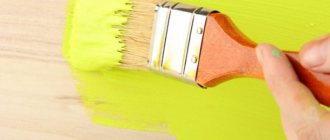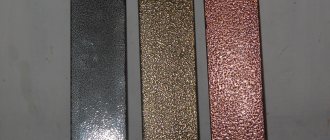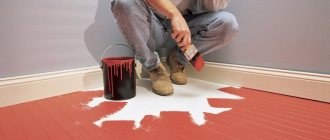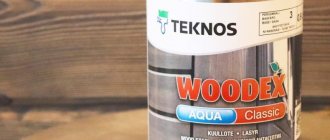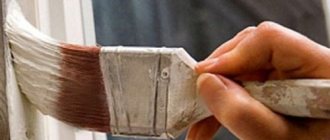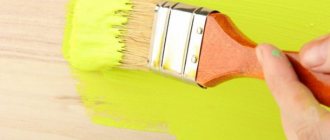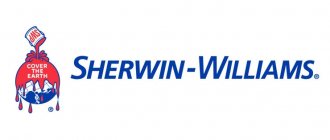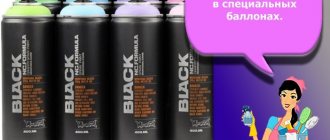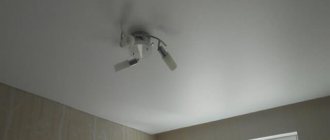There was a time when oil paint for walls was a little forgotten, after other, improved options began to appear on the market: enamel, acrylic, water-dispersion, latex and acrylic. They even began to say that oil paint was toxic and should not be used.
Let's try to figure out whether this is really so.
What is oil paint
This material was created quite a long time ago, but still does not lose its relevance. Oil paint is intended for covering surfaces indoors or outdoors. The type and purpose of the product is always indicated by the manufacturer; you should pay attention to this when purchasing this type of paint.
Oil enamel contains natural vegetable oils and drying oil. Moreover, such paint is a relatively budget option, especially when you need to cover a large surface area.
What kind of material is this?
The binding component in the composition is drying oil. Now this substance is produced mostly synthetically, since it is unprofitable to use natural oils due to their high cost. Mineral flour and other additives act as fillers, and inorganic pigments give the solution a certain color. The solvent allows you to achieve the desired consistency and degree of viscosity.
Where is paint containing drying oil used?
There are many areas of application for oil paints. It all depends on the composition and nuances of production. It covers:
- Walls.
- Roofs.
- Fences.
- Elements of garden interior.
- Benches, gazebos in parks.
Manufacturers produce oil paints for metal. When purchasing, you should pay attention to what surfaces this or that enamel is for.
Since the properties and composition of oil paints for walls differ significantly from coatings intended for wooden or metal surfaces. Moreover, it is important to look at the expiration date of this product. This is necessary because over time the paint changes its properties and may deteriorate towards the end of its shelf life.
Determining the type of coating
First you need to make sure exactly what type of coating is present on the wall. Here are the signs of different types of materials:
- The lack of shine, dullness, and silkiness of the surface means that it is coated with a water-based composition. It can be removed with a spatula after soaking it well.
- The appearance of a white coating on the hand after running along the wall is a sure “symptom” of the presence of lime whitewash. Wallpaper cannot be glued to it; it is important to completely remove the lime. Otherwise, after applying wallpaper glue, all the whitewash will fall off.
- Smooth, shiny, cold to the touch walls are a sign of painting with oil or enamel compounds. They remain unchanged for a long time, do not crumble, and do not fade.
Advantages of oil paint
Among the advantages of this material:
- Budget cost.
- Moisture resistance.
- Protective functions. These properties are especially good for wooden surfaces on which fungi and mold will not develop.
- Possibility to wash surfaces coated with oil enamel.
- Easy to apply.
- Economical consumption. The paint can be applied in one layer, and the coating will be of high quality.
- Wide range of shades.
Moreover, one of the main characteristics of oil paints is the possibility of even application, without streaks. And also environmentally friendly. Oil enamels are safe because they are made from natural ingredients.
In addition, such paints are resistant to temperature changes. Therefore, this material is indispensable when processing the facades of buildings and structures.
Advantages and disadvantages
No matter how much consumers argue, the scales tip towards the product's disadvantages rather than its advantages. And here we are talking not only about the real shortcomings of the material, but the whole point is in marketing policy. We will not consider it, but we will say one thing: each material has its own advantages and disadvantages. Let's look at them to draw our own conclusions.
So, let's start with the disadvantages of the material:
- Contains toxic solvents. They evaporate and can cause harm to human health. But it is worth noting that after 5 days of weathering, all toxins disappear. There is only a small chance of an allergic reaction.
- Lack of vapor permeability. The ceiling and walls are painted with oil paint and do not breathe. Sometimes this is a big disadvantage, since the walls of a living space do not support gas exchange and normal humidity in the building. However, we mentioned that there are rooms where this is not necessary.
- Weak elasticity of oil paints. The material has poor elasticity, so it is difficult for the coating to cope with temperature fluctuations, as well as changes in surface geometry. As a result, it cracks. This effect is absent in high-quality branded paints.
What can we say about the benefits of the products?
- Wear resistance and strength. Impacts, abrasion and mechanical stress are not so bad for the coating. This extends the service life.
- The versatility of the material. As we said, oil paint is suitable not only for walls and ceilings, but also for other products and surfaces of various types.
- Moisture resistant. This is why the material is so often applied to metal products. The paint is not afraid of water and it does not allow moisture to pass through.
- Easy to care for. The walls and ceilings are easy to clean, they are not afraid of chemicals and do not wear off.
- Excellent adhesion. It is not necessary to putty the walls to ensure high-quality adhesion of the material. When applied correctly, the coating will last a long time.
- Excellent value for money oil materials.
You can compare all the pros and cons of the material to understand whether you need this paint or not. And experienced consultants will help you decide which oil paint to choose.
Oil paint has disadvantages
This enamel takes a relatively long time to dry. The downside is that during the drying process, particles of dirt, dust, and small insects stick to the surface. In addition, oil paint is often intended for outdoor use, as it has a rather strong smell.
- This enamel is practically non-hygroscopic, i.e. does not conduct air.
- The surface covered with oil paint is provided with a kind of armor through which no substances can pass.
- If the layer was not applied according to the rules, this property can provoke the occurrence of condensation and, as a result, the appearance of mold.
Enamel created on the basis of drying oil is relatively short-lived. It begins to crack and change color. The surface will have to be painted again in a couple of years. It is often necessary to update the façade much earlier than this in order to give it an aesthetic appearance.
What kind of paint can acrylic paint be applied to?
To paint an oil base with an acrylic composition, first apply a primer mixture; it will create the necessary level of adhesion of the two products. The water-based base must be ideal, then it will be possible to apply an acrylic-based product. But it is always better to remove the previous finish. Then the coloring will be of high quality.
It is possible to use a latex layer on top; it is important that the acrylic is of high quality. Then the degree of adhesion will be good, the compositions will be able to adhere well.
It is possible to use a latex layer on top; it is important that the acrylic is of high quality.
What is the consumption of this enamel
The higher the absorbency of the surface, the more paint will have to be used when painting it. The percentage of consumption also depends on the thickness of the enamel.
On average, experts talk about a consumption of 150-170 g per square. Moreover, processing metal will require a smaller amount of drying oil, but wood will take up the enamels to the maximum.
Tips for wallpapering
Using a sufficient amount of the composition will help reduce the risk of the canvas coming off. If in doubt, it is better to coat both surfaces to be joined with glue, which will help strengthen adhesion. You cannot open the doors in the room, open the windows, or allow drafts to appear during the day - this will dry out faster. Working in high humidity indoors, at temperatures below +15 and above +26-27 degrees, will lead to a lower quality result.
Professionals usually completely remove paint from the walls. At home, you can carry out the work using a simplified method if you try and thoroughly prepare the walls. Then the wallpaper will last a long time and reliably.
How long does oil enamel take to dry?
The drying process takes at least a day. Some manufacturers guarantee complete drying 12-13 hours after finishing work with paint. But more often this process takes up to 30 hours.
- By the way, the drying time depends on the composition and thickness of the oil substance.
- The more concentrated it is, the faster the fixation process will take place.
- Some manufacturers recommend mixing the material with other components.
How to thin oil paint? If there are no specific instructions on the package, thick oil paint is brought to the desired condition with white spirit or turpentine. The additive should be no more than 5 percent by volume of the total mass.
Wallpapering
After mixing the glue according to the instructions, you can carry out the main process. You cannot change the ratio of glue and water - this will disrupt the quality of adhesion of the materials. Apply the adhesive composition to the canvas using a brush or roller. This rule applies to paper wallpaper. For other types of canvases, apply glue to the wall and wallpaper strip. For glass wallpaper and non-woven wallpaper, the composition is applied only to the wall.
The first strip is applied from the corner located closer to the window. Align the canvas so that it lies perfectly flat. Beginners are advised to pre-line the walls - this will help complete the job without defects. Smooth the cut with a plastic spatula or rag to remove any air bubbles. Next, glue the second sheet, butt-fitting it to the first one. To form beautiful joints, you can use a small rubber spatula. Then all the walls in the room are covered in the same way.
The top and bottom edges are cut under the baseboards with a stationery knife, first placing a spatula so as not to damage the walls. Cut out holes for sockets and switches.
Oil paint composition
It is simple and includes a minimum of components. Oil paint consists of drying oil and dye. Literally 20 years ago, manufacturers used absolutely natural ingredients, “extracted” from plants. These are essential oils that were the basis of drying oil.
Modern manufacturers have learned to make synthetic drying oil. It doesn't smell as strong and dries much faster. Recently, factories have been mixing natural and artificially created drying oils to obtain an even higher quality oil mass.
Depending on the proportions in which these and other components are used, the following types of oil paint are distinguished:
- Natural.
- Combined.
- Pentaphthalic.
- Alkyd.
- Oxol.
The pigments used are usually natural. These are ocher, zinc, lead, and other coloring minerals.
How to choose oil paint
Before purchasing such products, you should pay attention to the information provided on the packaging. Volatility characteristics should not exceed 10%, otherwise the paint will emit too strong an odor.
There should be about 25% of film-forming substances responsible for the density of the composition. The denser the emulsion, the better the quality.
In addition, it is important to consider the following indicators:
- Particle grain size is at least 90 microns.
- Viscosity – not lower than 60 units.
- Approximate consumption per square meter – at least 150 g.
The packaging will indicate the drying speed, which is also worth paying attention to.
Procedure for working with oil paint
The old coating should be removed from the surface, sanded, cleaned, degreased, and dried. Then fill the cracks with putty and go over a couple of layers of primer.
It is better to apply the oil paint itself in a thin layer. If you need to do a second staining, the first tier must be thoroughly dried.
Application
One of the options for interior decoration is painting the walls with oil paint. It's practical, inexpensive and simple. This is especially true for surfaces already painted with this composition, since the preparatory process will be significantly simplified:
- a similar solution will work perfectly on oil paint if there are no cracks or other defects on the surface; adhesion will be at the highest level;
- you will avoid the tedious and lengthy process of removing old paint, which sometimes costs a pretty penny.
Where to begin?
They always start by cleaning the walls. They are washed if the problem is only accumulated dirt. They are cleaned using a spatula, scraper, drill with special attachments, a hair dryer or chemical compounds designed to remove old paint (washes) if the coating is in poor condition. In this case, surface leveling is also required. At this stage, putty starting and finishing mixtures and sandpaper are used.
A flat and smooth wall is completely cleaned of dust (you can use a household vacuum cleaner) and primed.
The need for a primer is as follows:
- The consumption of coloring material is reduced.
- Improves paint adhesion to the surface.
Primer mixtures often contain antiseptics, which is very important when finishing rooms with high levels of humidity; This way you can protect the room from mold and other harmful microorganisms.
The simplest tools will do:
- paint brushes and roller,
- paint cuvette,
- adhesive masking tape.
If you have a paint sprayer, you can use it. In any case, first cover the joints with the ceiling, door jambs, baseboards, sockets and switches with masking tape. Now you can paint.
